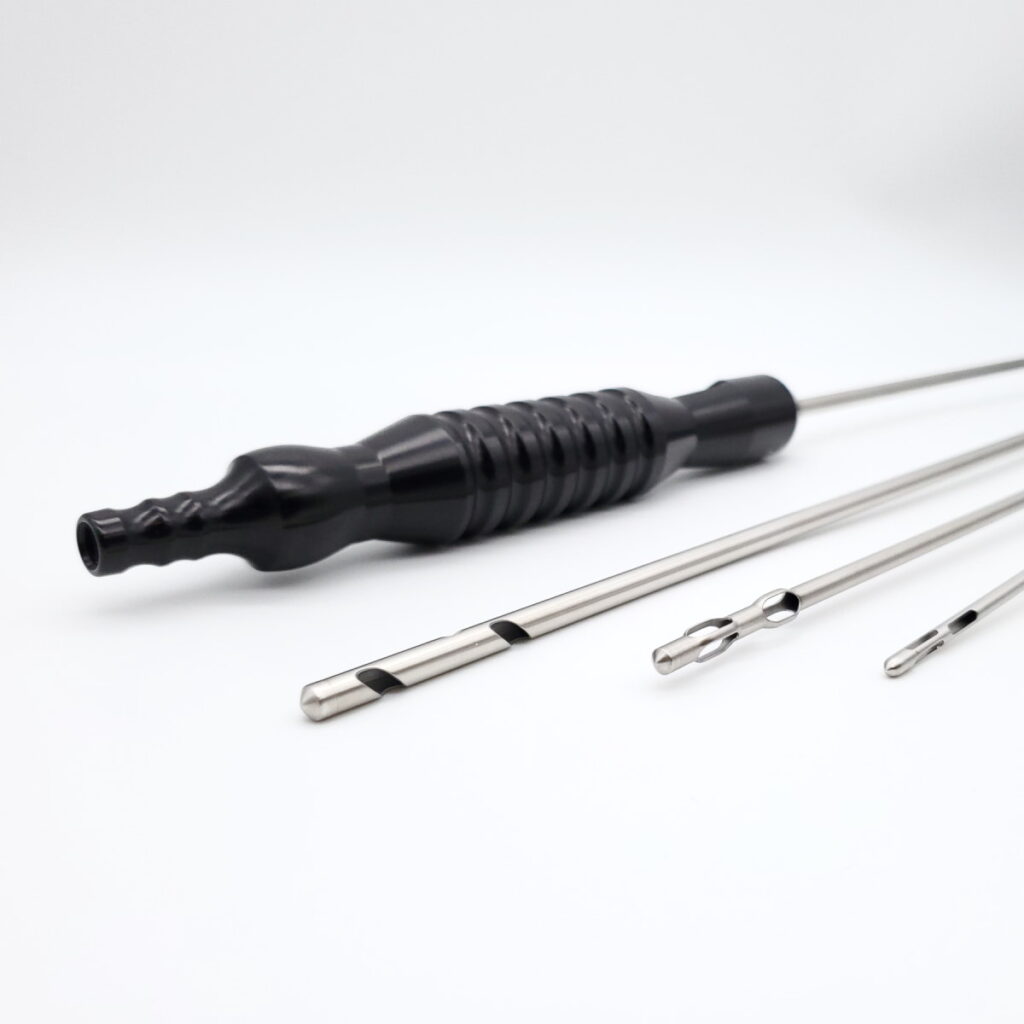Introduction: The Art and Science Behind Modern Fat Transfer
In modern cosmetic and reconstructive surgery, precision is everything. From the shape of a surgeon’s incision to the type of instrument used, every detail influences patient outcomes. One of the most transformative innovations in recent years is the Spoon Tip Fat Injection Cannula, a surgical instrument designed for maximum accuracy and safety in fat transfer procedures.
Fat transfer, also known as autologous fat grafting, involves removing fat from one area of the body and re-injecting it into another to restore volume or correct contour irregularities. The process may sound straightforward, but its success hinges on the instruments used, and that’s where the Spoon Tip Cannula has redefined the standard.
In this comprehensive guide, we’ll explore:
- What makes the Spoon Tip Fat Injection Cannula unique
- How it compares with the Toledo V Dissecting Fat Injection Cannula
- Its applications in cosmetic and reconstructive surgery
- Real-world examples, pros and cons, and expert insights
- Maintenance tips, FAQs, and the future of fat transfer instruments
Whether you’re a medical professional, clinic manager, or a curious patient researching your procedure, this article covers everything you need to know.
The Evolution of Surgical Fat Transfer Instruments
Before modern designs like the Spoon Tip or Toledo V Cannulas emerged, fat transfer was far more invasive. Surgeons relied on blunt or sharp metal tubes that often caused tissue trauma, uneven fat distribution, and poor graft survival rates.
Over the years, advancements in liposuction and injection cannula design have made procedures safer, more predictable, and more natural-looking.
The transition from traditional to micro and nano fat transfer has revolutionized outcomes, thanks in large part to specialized cannulas that control fat flow, minimize trauma, and preserve viable cells for grafting.
Instruments like the Spoon Tip Cannula have become indispensable tools in achieving smooth contours, longer-lasting volume retention, and faster recovery times.
What Is a Spoon Tip Fat Injection Cannula?
The Spoon Tip Fat Injection Cannula is a slender, hollow stainless-steel instrument designed for injecting purified fat into targeted tissues with controlled precision. Its defining feature is a smooth, spoon-shaped tip that allows for even distribution of fat with minimal tissue disruption.
Unlike traditional cannulas that can scrape or tear tissue, the spoon tip glides smoothly beneath the skin, ensuring a gentler and more predictable injection process.
Key Design Features:
- Spoon-shaped, blunt tip that prevents tissue injury
- Lateral microports for uniform fat dispersion
- Ergonomic handle for superior control and stability
- Medical-grade stainless steel for durability and sterilization compatibility
This design enhances the surgeon’s dexterity and patient comfort, making it the preferred choice in delicate fat transfer areas like the face, under-eyes, and hands.
How the Spoon Tip Fat Injection Cannula Improves Fat Graft Precision
Fat grafting success depends largely on cell survival; the more viable fat cells transplanted, the longer and smoother the results. The Spoon Tip Cannula plays a vital role in this by ensuring that fat is deposited in micro-droplets rather than clumps, allowing the tissue to absorb nutrients efficiently.
Clinical Advantages Include:
- Reduced trauma to recipient tissues
- Improved fat survival rates due to even dispersion
- Smoother aesthetic outcomes with fewer irregularities
- Enhanced control during injection, even in delicate zones
This is particularly important in nano fat transfer procedures where precision and uniformity are crucial for skin rejuvenation and fine contour corrections.
Applications of Spoon Tip Fat Injection Cannula in Surgery
The Spoon Tip Cannula is highly versatile and used in multiple aesthetic and reconstructive surgeries.
1. Facial Fat Grafting
In facial rejuvenation, the cannula helps restore lost volume in areas like:
- Cheeks and temples
- Tear troughs and nasolabial folds.
- Lips and chin
Its precision enables micro-fat injections that mimic natural tissue contours, resulting in smoother, more youthful appearances.
2. Breast Reconstruction and Augmentation
For patients undergoing reconstruction after mastectomy or cosmetic enhancement, the spoon tip allows layered, even fat placement. This ensures symmetrical shape and minimizes the risks of nodularity or fat necrosis.
3. Buttock Enhancement (BBL)
In procedures such as the Brazilian Butt Lift, surgeons rely on spoon-tip cannulas to deposit fat in controlled layers for a natural, firm contour.
4. Hand Rejuvenation
By carefully injecting nano fat, the cannula helps conceal veins and restore youthful fullness to aging hands.
Toledo V Dissecting Fat Injection Cannula: A Complementary Tool
While the Spoon Tip Cannula is designed for smooth, even fat injection, the Toledo V Dissecting Fat Injection Cannula serves a slightly different purpose.
Distinctive Features of the Toledo V Cannula:
- A V-shaped cutting tip is ideal for fibrous or scarred tissue
- High flow control suitable for dense graft areas
- Dissecting function that allows simultaneous tissue separation and fat placement
This cannula is often used in secondary fat grafting procedures, revision surgeries, or in areas with fibrotic tissue where precision dissection is required.
When to Choose Each:
| Surgical Goal | Ideal Cannula |
| Smooth tissue fat placement | Spoon Tip Cannula |
| Dense or fibrotic tissue dissection | Toledo V Cannula |
Most experienced surgeons use both instruments in tandem for optimal results, beginning with the Toledo V for initial dissection and switching to the Spoon Tip for smooth finishing.
Integration with Nano Fat Transfer Techniques
The rise of nano fat transfer has taken aesthetic medicine to the next level. This refined technique processes harvested fat into micro-particles rich in stem cells and regenerative factors. These cells help improve skin texture, elasticity, and healing.
The Spoon Tip Cannula is fully compatible with Nano Fat Transfer Kits, allowing precise delivery of these regenerative particles into superficial layers of the skin.
Applications in Nano Fat Transfer:
- Treating fine lines and wrinkles
- Scar revision
- Under-eye rejuvenation
- Hand and neck skin tightening
With its smooth tip and small injection ports, the Spoon Tip Cannula ensures even dispersion of nano fat for natural, long-lasting results.
The Role of Infiltration Cannulas in Fat Harvesting
Before injection, Infiltration Liposuction Cannulas are used to deliver tumescent fluid (a mix of saline, lidocaine, and epinephrine) into the donor site.
This step minimizes bleeding, eases fat removal, and preserves fat cell integrity.
Curved vs. Straight Infiltration Cannulas
- Curved Cannulas – Provide ergonomic access to contoured areas like flanks or inner thighs.
- Straight Cannulas – Ideal for linear regions such as the abdomen.
Both types complement the Spoon Tip Cannula, forming a complete system from fat harvesting to reinjection.
Clinical Benefits of Spoon Tip Fat Injection Cannulas
1. High Fat Graft Survival Rate
Due to the smooth, controlled injection, more fat cells remain viable after transfer.
2. Minimal Tissue Damage
Rounded tips reduce bruising, swelling, and patient downtime.
3. Better Aesthetic Outcomes
Uniform fat layering avoids lumps or uneven textures.
4. Surgeon Control and Precision
Enhanced tactile feedback allows surgeons to feel tissue resistance, ensuring accurate placement.
Maintenance and Sterilization Best Practices
For surgical instruments, sterilization is critical to maintaining function and preventing infection.
The Spoon Tip Cannula should be:
- Rinsed immediately after use with an enzymatic cleaner
- Cleaned ultrasonically to remove debris
- Autoclaved at 134°C for at least 15 minutes
- Stored in sterile trays away from moisture
Regular inspection ensures ports remain open and tips remain smooth, extending the lifespan of the instrument.
Case Studies: Real-World Results
In a 2024 clinical trial published in Aesthetic Surgery Journal, surgeons using the Spoon Tip Fat Injection Cannula reported a 95% patient satisfaction rate and higher graft survival compared to traditional blunt-tip
Advanced Applications of the Spoon Tip Fat Injection Cannula
1. Autologous Fat Transfer for Reconstructive Surgery
Beyond cosmetic enhancement, fat grafting plays a vital role in reconstructive surgery, particularly in post-traumatic and post-oncologic reconstructions.
The Spoon Tip Cannula enables surgeons to inject fat precisely into irregular or scarred tissues, helping:
- Correct contour deformities from accidents or burns
- Improve skin texture over irradiated tissue.
- Restore natural volume in post-mastectomy breast reconstruction
Because of its gentle design, it avoids damaging delicate vascular networks — critical for fat graft survival in compromised tissue environments.
2. Stem Cell–Rich Fat Grafting
Modern regenerative medicine integrates stem-cell-enriched fat grafting using nano fat techniques. The Spoon Tip Cannula, when paired with a Nano Fat Transfer Kit, helps deliver adipose-derived stem cells (ADSCs) directly into the dermal and subdermal layers.
This combination promotes:
- Enhanced skin regeneration
- Improved scar healing
- Superior collagen production
It’s now a key component in anti-aging facial procedures and scar management protocols across leading clinics worldwide.
3. Combination Procedures with Infiltration Cannulas
Fat transfer often begins with infiltration using Infiltration Liposuction Cannulas or Infiltration Curved Liposuction Cannulas to deliver tumescent anesthesia. Once the fat is harvested and purified, the Spoon Tip Cannula takes over for controlled re-injection.
This two-step process ensures minimal trauma at both the donor and recipient sites. Surgeons often use curved infiltration cannulas for better ergonomic reach during donor preparation, enhancing procedural efficiency.
Ergonomics and Surgeon Experience: Why Design Matters
Surgical precision isn’t just about the patient; it’s also about the surgeon’s comfort and control.
The Spoon Tip Cannula’s balanced weight distribution and ergonomic handle minimize fatigue during long procedures.
Surgeons report:
- Better tactile feedback when navigating tissue layers
- Less hand strain during repetitive micro-fat injections
- Enhanced confidence in achieving symmetrical results
This user-focused design represents a shift in surgical instrument engineering, prioritizing both human ergonomics and tissue safety.
Material Quality and Engineering Standards
High-quality surgical-grade stainless steel (316L) is the preferred material for Spoon Tip and Toledo V Cannulas. It offers:
- Corrosion resistance for repeated sterilization
- Non-reactive surface to prevent tissue contamination
- Precision machining for consistent lumen size and flow
Top manufacturers now apply laser calibration to ensure uniform internal diameters, a critical factor affecting flow resistance and injection smoothness.
Surgeons are encouraged to purchase instruments that meet ISO 13485 and CE certifications, ensuring global safety and performance standards.
Innovation Spotlight: Smart Cannulas and Fat Transfer Technology
The next generation of fat injection tools includes smart cannulas with integrated pressure sensors and flow regulators. While still in early development, these innovations could:
- Automatically regulate fat flow to avoid over-injection
- Provide real-time tissue resistance feedback.
- Track procedural data for improved training and safety
Some high-end surgical centers are already experimenting with robot-assisted fat injection systems, where instruments like the Spoon Tip Cannula can be attached to robotic arms for ultra-precise, repeatable injections.
This fusion of AI, robotics, and surgical craftsmanship represents the future of aesthetic medicine.
Safety Considerations in Fat Grafting
Fat transfer remains one of the safest procedures in aesthetic surgery when performed correctly. However, complications can occur if instruments are misused or fat is injected into the wrong tissue plane.
Key Safety Guidelines:
- Always use blunt-tip cannulas (like the Spoon Tip) to prevent vascular penetration
- Avoid high-pressure injections to minimize fat embolism risks.
- Use ultrasound guidance in high-risk zones (e.g., buttocks, breast)
- Follow sterilization protocols meticulously to prevent infection
These best practices are reinforced by international bodies such as the American Society of Plastic Surgeons (ASPS) and the International Society of Aesthetic Plastic Surgery (ISAPS).
Global Trends in Fat Transfer Procedures (2025 and Beyond)
The demand for natural-looking aesthetic results continues to rise. Fat grafting is now considered a cornerstone of modern plastic surgery, driven by patient preference for biocompatible, long-lasting results.
Emerging Trends Include:
- Nano fat & stem-cell-enhanced grafting for regenerative treatments
- Hybrid fat-filler combinations (mixing fat with hyaluronic acid)
- Minimally invasive cannula systems for outpatient procedures
- Disposable sterile cannulas for single-use infection control
The Spoon Tip Fat Injection Cannula remains central to these innovations, combining safety, precision, and adaptability to evolving techniques.
Expert Insights: Surgeon Testimonials
“The Spoon Tip Cannula has completely changed how I approach facial fat transfer. The smooth flow and even dispersion produce more natural contours with less post-op bruising.”
— Dr. Laura Kim, Plastic Surgeon, Seoul Aesthetic Center
“For dense tissue grafts, I pair the Toledo V Dissecting Cannula with the Spoon Tip. The combination offers both control and finesse, perfect for complex revisions.”
— Dr. Ahmed Rahman, Reconstructive Surgeon, Dubai Medical Institute
Such real-world feedback underscores the clinical trust these tools have earned worldwide.
Maintenance: Extending the Life of Surgical Instruments
High-quality surgical cannulas can last 3–5 years if properly maintained. Following strict sterilization and inspection routines prevents clogging, deformation, or corrosion.
Maintenance Checklist:
- Pre-cleaning: Flush with sterile water immediately post-procedure.
- Ultrasonic Cleaning: Remove microscopic debris using an enzymatic detergent.
- Autoclaving: Maintain 134°C for 15–20 minutes.
- Inspection: Check for blocked ports or bent shafts under magnification.
- Storage: Use dry, sealed containers with instrument-specific trays.
Proper care ensures optimal performance and safety during every procedure.
Training and Skill Development for Surgeons
The use of specialized instruments like the Spoon Tip Cannula requires technique-specific training. Surgeons must understand tissue resistance, injection pressure, and fat viability factors.
Global training programs now offer hands-on workshops in:
- Nano fat and micro fat transfer
- Cannula handling techniques
- Complication management
Certified courses from associations like the ISAPS Academy and American Academy of Cosmetic Surgery (AACS) are invaluable for mastering these advanced procedures.
Environmental and Ethical Considerations
As healthcare moves toward sustainability, manufacturers are investing in eco-friendly production of surgical instruments.
Modern Spoon Tip Cannulas are often:
- Produced using low-waste machining
- Packaged in recyclable materials
- Offered in reusable models to minimize medical waste
Clinics adopting green practices not only reduce their environmental impact but also appeal to eco-conscious patients.
The Future of Fat Transfer: Where Innovation Meets Aesthetics
Looking ahead, fat transfer procedures will become even more personalized. With advances in biotechnology, AI-assisted injection systems, and 3D imaging, surgeons will be able to design fully customized fat grafting maps.
The Spoon Tip Cannula, already known for its safety and precision, will likely evolve with integrated sensors and ergonomic refinements.
Ultimately, as technology enhances human capability, patients will continue to benefit from procedures that are safer, more precise, and more natural than ever before.
Final Thoughts: Why Precision Instruments Defines Surgical Excellence
The Spoon Tip Fat Injection Cannula is more than a surgical instrument — it’s a symbol of modern surgical innovation.
Its ability to deliver consistent, trauma-free fat placement makes it a critical tool for surgeons striving for natural, lasting results.
Combined with the Toledo V Dissecting Cannula and modern tools like Nano Fat Transfer Kits, it represents the gold standard in autologous fat grafting.
If you’re a clinic or practitioner aiming to elevate your surgical results, investing in precision-engineered instruments is the first step toward achieving true surgical artistry.



